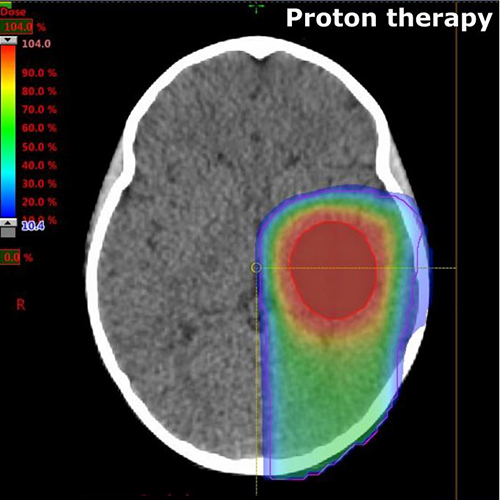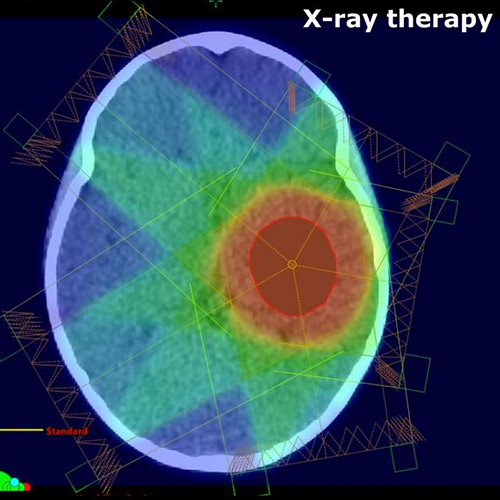12 November 2020

Adelaide is poised to open Australia’s first proton therapy centre in 2025, with children and young adults expected to be the main beneficiaries of more effective cancer treatment with fewer side effects.
But just how safe is proton therapy for children with brain cancer compared to the conventional x-ray radiation delivered post-surgery?
A new study by University of South Australia (UniSA) researchers will explore this question over the next two years, using data from a US hospital to model patient outcomes based on individual cancers, radiosensitivity, sex and age of the children.
UniSA PhD candidate Mikaela Dell’Oro and her supervisors (Dr Michala Short, Dr Puthenparampil Wilson and Prof Eva Bezak) have been awarded $100,000 by the Channel 7 Children’s Research Foundation to lead the project, which will assess the risk of developmental disorders in children as a result of using proton beams to treat paediatric brain tumours.

Compared to conventional x-ray (photon) therapy, proton beam therapy superiorly targets tumours and cancer cells, delivering optimal radiation doses to the tumour while limiting the effects on the surrounding healthy tissues.
“This is particularly important when treating brain tumours in children because their brains are at a sensitive stage of development and highly susceptible,” says Dell’Oro.
Protons are designed to deposit radiation more conformally to the target volume, sparing both the healthy tissues before and beyond the target as well as critical structures surrounding the tumour.
“We know that proton therapy has fewer developmental side effects on children with brain tumours, but we need to dig deeper and find out how age, sex and an individual’s sensitivity to radiation also mitigate or increase the risk,” Dell’Oro says.
It is thought that females and younger patients are more sensitive to radiotherapy but existing research is based on adult data which is more than five years old – considered outdated in a rapidly advancing field.
“The techniques used in radiotherapy – both proton beam therapy and x-rays – have come a long way since then and we need to develop new modelling to predict the risk of secondary primary cancers and other complications in children.”
UniSA researchers will use computed tomography data sets from St Jude Children’s Research Hospital in Memphis, Tennessee, a paediatric treatment and research facility specialising in childhood cancers. This data will help local researchers build a mathematical model to predict patient outcomes.
Brain tumours comprise 20 per cent of all childhood cancers and account for the largest number of paediatric cancer deaths in Australia at 39 per cent. They are treated with a combination of surgery, chemotherapy and radiotherapy, all associated with risks.
Radiotherapy is responsible for a range of mild to severe neurologic, endocrine and cognitive negative effects in children. Because proton therapy is more targeted, it is the preferred treatment for children.
“From what we know, proton therapy has less severe side effects and similar survival outcomes, but there is still a huge gap in our knowledge.
“It takes years to observe physical side effects and clinical trials are difficult due to practical reasons, so we need to look at computational modelling to estimate the risks for patients,” Dell’Oro says.
The number of proton therapy centres is rapidly expanding around the globe, with 89 facilities worldwide, predominantly in the United States, but also in Europe and Asia.
The Australian Bragg Centre for Proton Therapy and Research will be the country’s first, located in the South Australian Health and Medical Research Institute (SAHMRI) on North Terrace.
It is anticipated the centre will treat up to 700 patients a year, with around half of these children and young adults.
In a paper recently published in the journal Cancers, the researchers compared the latest proton and photon radiation delivery techniques for paediatric patients across three age groups. Proton therapy reduced irradiation in all cases compared to photon therapy (conventional x-ray radiation therapy).
Media contact: Candy Gibson office +61 8 8302 0961 mobile: +61 434 605 142
email: candy.gibson@unisa.edu.au;
UniSA researchers: Mikaela Dell’Oro mobile: 0435 214 264 email: mikaela.delloro@mymail.unisa.edu.au; Prof Eva Bezak mobile: 0401 712 452 email: eva.bezak@unisa.edu.au



